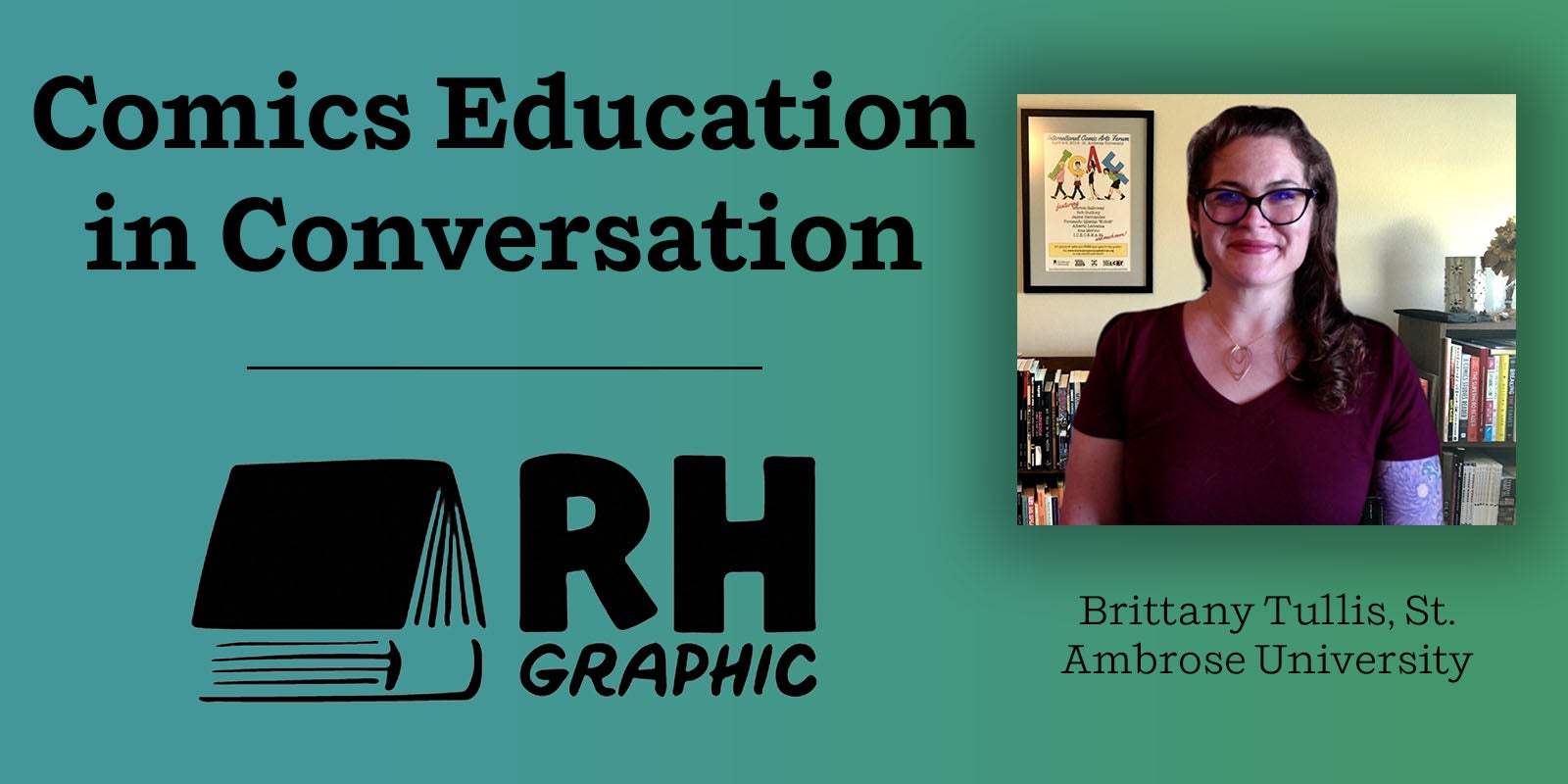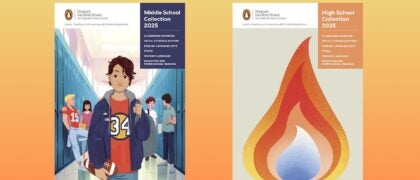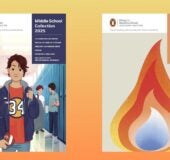Brittany Tullis is Associate Professor of Spanish and Women and Gender Studies at St. Ambrose University, where she teaches classes on Latin/x American and international feminist comics in both English and Spanish. Her published work appears in Hispanic Issues On Line, the International Journal of Comic Art, Comics Studies: Here and Now!, and her co-edited Eisner award-nominated collection, Picturing Childhood: Youth in Transnational Comics. Brittany serves as Academic Director of the International Comic Arts Forum and as the First Vice President of the Comics Studies Society.
How did you get started reading comics?
I came late to comics readership – I actually didn’t read my first comic (other than strips in the newspaper) until graduate school. I was starting a Ph.D. in Hispanic Literatures at the University of Iowa in 2008 when I took a 20th Century Latin/x American literature class with a professor who included the classic Love & Rockets story “The Death of Speedy” in his readings schedule – I instantly hooked, and tore through huge swaths of the Hernandez brothers’ catalog over the following winter break. Luckily for me, Dr. Ana Merino, an enormously talented Latin/x American comics scholar as well as a celebrated author, had just been hired in the Department of Spanish and Portuguese to teach classes on comics and creative writing, and so I was able to begin working with her the following semester. She would end up being a tremendous influence and touchstone in my life and not only directed my study of comics for years to come but also staunchly defended my choice to do so. By the time I graduated in 2014, I had dedicated a vast amount of time reading and studying comics, particularly Latin/x American comics, and also wrote the first dissertation on comics in my department – and perhaps the first dissertation on Latin/x American comics at the University of Iowa. So unlike most comics scholars I know, the majority of whom grew up reading comics and later found ways to legitimate their study during their graduate careers, I actually discovered comics in an academic setting and set about both reading and studying them at the same time.
Have you seen a change in the academic reception of comics and graphic novels over the course of your career?
Although I am a very recently tenured professor, having received my Ph.D. in 2014, there has indeed been a change in the academic reception of both comics and comics studies even over the course of this short period of time. Many more graduate students are finding the support and mentorship necessary to undertake dissertation-level study of comics, and not just in English departments, but in World Languages and Women’s and Gender Studies and virtually all throughout academia. This past spring I was honored to serve on a dissertation committee for a doctoral candidate who was defending a dissertation on Latin/x American comics from the department I graduated from only six years previously, when writing a dissertation solely on comics seemed like a wild proposition to some of the faculty. Luckily, they not only trusted me to undertake that study and do that work but were able to also see the value in it. I am very glad to know that they have continued to support other students who chose to follow a similar path.
I imagine similar stories have played out in a number of departments throughout academia and that this has helped create a groundswell of support for increased recognition surrounding teaching and scholarship in comics studies. While it’s a discipline that has been growing for decades, this past decade has seen some tremendous growth and solidification of the field, from numerous dedicated comics studies conferences springing up to the foundation of the Comics Studies Society in 2014, which seeks to serve as an institutional hub and supportive professional network for comics scholars.
You’re also the vice president of the Comics Studies Society. What does the CSS do, and should academics and educators interested in comics get involved?
The Comics Studies Society (CSS) is an interdisciplinary professional society that seeks to promote the critical study of comics and provide professional development opportunities and support to its members. We host an annual conference where scholars both new and established can share their work with their peers, and we also publish a professional journal called INKS. Above all, CSS provides a network for scholars to share ideas and grow in their scholarship, and we have a dedicated Executive Board and Graduate Student Caucus (GSC) that work very hard to provide professionalization opportunities for graduate students and junior faculty members, such as the mentoring program that the GSC has been carefully developing to connect up-and-coming scholars with more established scholars in the field. I’m proud to say that CSS is also an organization that takes the issue of accessibility very seriously, which is why we not only offer a number of travel grants for students and contingent faculty, but also continue to examine our conference organization practices very carefully to ensure that we’re creating a welcoming and inclusive space for all of our members and attendees. For more information about CSS and how to become a member, please visit our website at http://comicssociety.org
You’ve written about Latinx representation in comics. Is that something you’ve seen grow over the course of your career?
Absolutely. For one thing, the kinds of representation one sees in comics has really evolved, primarily because there are so many Latinx creators publishing comics that tell their own stories. Featuring Latinx protagonists and casts of characters that transcend and subvert the kinds of stereotypes that are (re)produced far too often in comics created by Anglo creators, Latinx-created comics are also pushing at the boundaries of the medium in other important ways, helping to further evolve comics and comics studies as whole.
Furthermore, the number of dedicated conferences and cons celebrating Latinx comics is really flourishing right now, largely because of the blood, sweat, and tears of folx who have been grinding non-stop to make these things happen. When I think of people behind this kind of work I think of Frederick Luis Aldama, for example, who has been doing a tremendous amount of work to grow Latinx comics studies since before I started graduate school. Not only did he start SÕL-CON: The Brown, Black, & Indigenous Comics Expo at The Ohio State University in 2015, which continues to be an excellent event that I look forward to every year, he also publishes about a gazillion books a year on the topic (I don’t know how he does it), serves as an influential mentor for up-and-coming young scholars, and just generally serves as a huge signal booster for the topic of Latinx representation in comics and film. When I look around at related events cropping up around the country, I know that it’s folx like Frederick making them happen; people who are so invested in promoting the excellent work being done in Latinx comics that they’re putting in the extra hours to organize conferences and cons at their institutions and in their communities. And what they’re finding is that people show up – like REALLY show up! – which is such an important message to the administrators and community leaders who note their successes. The more events taking place that get traction and recognition, the more resources will be poured into the coffers that support not only those events but related programs, as well. So if you see an event like this taking place in your community, go check it out! Not only will you learn something new, you’ll be supporting future initiatives just by being there.
You’ve also written about childhood and representations of youth in comics. I’d love to hear more about that.
My dissertation was really focused on representations of women and girls in Latin/x American comics, so I’ve given a number of talks and published a series of articles related to that research. I had the good fortune to meet Dr. Mark Heimermann at the International Comic Arts Forum (ICAF) in 2013, on whose executive board Mark currently served. As such, he was moderating the panel on which I gave a talk about the precocious child protagonist in Quino’s beloved Argentine strip, Mafalda. Mark and I later connected and talked at more length about our shared interest in the topic of childhood and its representation in comics and this is how Picturing Childhood: Youth in Transnational Comics (University of Texas Press, 2017) eventually came to be. Mark had already had the idea of editing a collection; he essentially invited me to join him in undertaking that project. It was a really rewarding experience for both of us, I think, and I feel really lucky not only to have stumbled upon the opportunity to edit a collection that spoke so directly to my own interests and concerns, but to have worked on this project with Mark, as well, who was a tremendous co-editor.
While comics and childhood have long been intertwined in the public imaginary, at the time that we undertook this project there weren’t any book-length projects that explored representations of children in comics over the course of the twentieth and into the twenty-first century. We knew that we wanted to take an international approach to this exploration, too, which meant that we wouldn’t be able to cover everything but that it could at least offer the beginnings of the sort of work that we both wanted to see more of in the field. We were lucky to receive a number of excellent essays for inclusion in the collection; our contributors really made that part of the job easy with the strong work they did. When we were nominated for an Eisner for that book in 2018, we were both very clear on the fact that we couldn’t have achieved that nod without the excellent work provided by our contributors, including that of Qiana Whitted (who won an Eisner award this year for her own book: EC Comics: Race, Shock, and Social Protest (Rutgers University Press, 2019), Pamela Roberston Wojcik, C.W. Marshall, Annick Pellegrin, Ralf Kauranen, Tamryn Bennett, and many more. We are both very proud of that book and also very heartened that more excellent work continues to be done in this area; Lara Saguisag’s Incorrigibles and Innocents: Constructing Childhood and Citizenship in Progressive Era Comics (Rutgers University Press, 2018) and Michelle Abate’s Funny Girls: Guffaws, Guts, and Gender in Classic American Comics (University Press of Mississippi, 2018) are two recently published books that I can’t recommend highly enough in terms of their contributions to both childhood studies and comics studies.
What are you working on now?
In addition to helping organize conferences for both CSS and ICAF (both organizations are running virtual events this and next year), I’m also starting work on a book of my own. This book will bring together research that I’ve been doing essentially since I finished my dissertation in 2014; I’m exceedingly grateful to my home institution, St. Ambrose University, for awarding me sabbatical leave to focus on drafting the manuscript. It’s tentatively titled Graphic Narratives of Resistance: Counter-storytelling in Latin/x American Comics. It seeks to demonstrate the ways in which comics have served as an important site of resistance in countering hegemonic discourses while also highlighting the experiences of marginalized subjects and the communities of which they form a part. Furthermore, it seeks to destabilize the narrative surrounding cultural exchange between North and South, demonstrating the multiple threads of influence that travel back and forth across the Americas, not only from North to South but from South to North, as well. Some of the comics I discuss in this book include U.S. Latinx titles Love and Rockets (Los Bros. Hernandez, 1982-present), Diary of a Reluctant Dreamer (Alberto Ledesma, 2017), and Darkroom (Lila Quintero Weaver, 2012), as well as Latin American comics La guerra por el agua (Jesús Cossio, Nelly Luna Amancio, and Jason Martínez, 2017), Diario Íntimo de Maliki 4 Ojos (Marcela Trujillo, 2011) and work produced by the “Tetastristes” feminist comics collective (Chile).
Favorite or new graphic novel recommendations?
It has been a tough year to stay current on recent releases but the extra time at home has given me the chance to read some things that have been waiting patiently on my bookshelf. Comics I’ve read and loved recently include Jaime Hernandez’s Is This How You See Me?, Ebony Flowers’ Hot Comb, Tillie Walden’s On a Sunbeam, Una’s Becoming/Unbecoming, and Drawing Power, edited by Diane Noomin.
I’m currently reading and working through Lynda Barry’s Making Comics (Drawn and Quarterly, 2019), which is the pandemic read of the year, in my opinion. If you haven’t done so already, do yourself a favor and get a copy at your local bookstore – it’s the perfect book to get you through a socially distant winter. In it, Barry provides a series of exercises used in the classes she teaches to go about telling stories using pictures and words. Too scared to draw a person? No problem – Barry will guide you through the Brunetti method (she’ll also tell you to lean into the weird shapes and figures that come out of your pen if you’ll let them). It’s a whimsical, fun, challenging book and guided practice that just might change the way you think about your own ability to draw and communicate in the language of images. Give it a shot!





